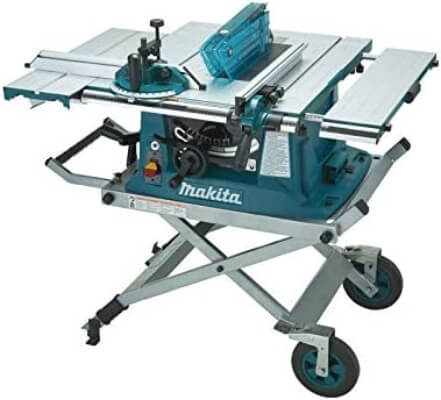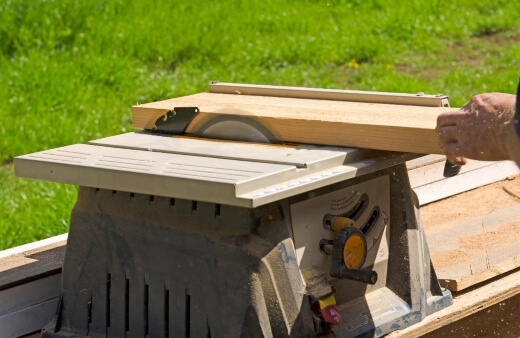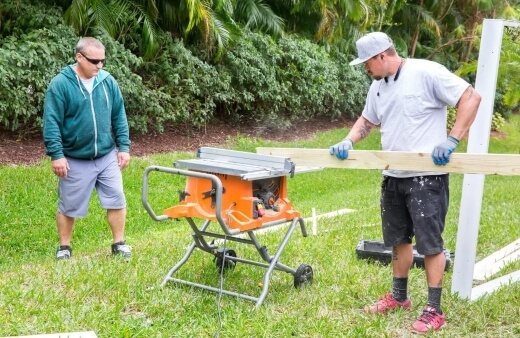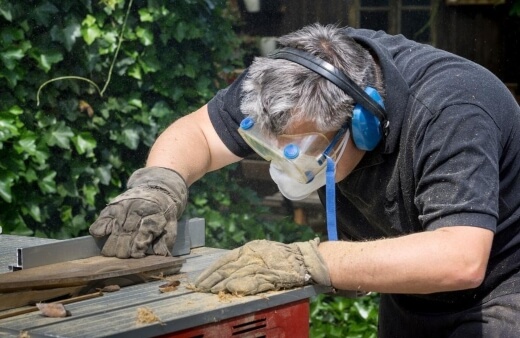Before we start, it’s worth getting one myth out the way; table saws are not becoming obsolete. Table saws are an irreplaceable tool, which are key to many industries, precision manufacturing and passionate DIYers like us.
If you have limited space, then table saws might not be practical for you at home, but for anyone with workshop space available, a table saw is a great investment.
In this article, we’re going to run through how to use them, and how to choose the best table saw for your workshop.
More...
Best Value


Best Table Saws in Australia
Product | Our Rating | Price | |
|---|---|---|---|
1. Makita MLT100N/2 Corded Table Saw |  |  |
Tool Buyer’s Guide to Table Saws
What is a Table Saw?

A table saw is a circular saw blade mounted into a slotted table top. Table saws are typically capable of mitre cuttings, and larger models have sliding tables combined with jigs to guide cuts evenly and accurately.
There is no way to replace a table saw at home with the same degree of accuracy, but smaller models provide most of the capabilities for DIY users provided they are set up on flat ground.
When to Use a Table Saw
Table saws are only advised for woodworking. Their saw blades are not designed for cutting plastic, metal or brittle materials which are almost guaranteed to splinter under the downward pressure of the blade.
If you are cutting several identical pieces of timber then table saws provide exacting measurements over and over again, with guides which remain in place.
The blade, which rotates towards the materials, prevents timber from being thrust upwards too, making it much easier to cut sheet timber than with a circular saw or mitre saw.
For more on when to use a mitre saw stand, click on our in depth buying guide below:
What to Look for When Buying a Table Saw
Table saws are all 1500W or upwards, and all are fully electric as they are designed for use in static positions in workshops. This means that there is very little in the way of power or capabilities that differs between models.
The only real differentiators are the safety features, size and the manufacturing quality of the guides (which can vary greatly).

Battery Vs Corded Table Saws
While table saws are traditionally static tools, you can buy portable, or battery-powered table saws, which reduce the risk of wire trip hazards in the workshop, and allow carpenters the luxury of remote working – which is particularly useful for remote working on jobs like fitted wardrobes, or installing outdoor kitchens.
Table Saw Guides
All table saws come with guides in one way or another. It’s incredibly important to find a table saw with well-manufactured guides that feature accurate measurements, and have simple, easy-to-use, but sturdy locking mechanisms.
Our old table saw was great, but had a really tough locking mechanism on the Rip Fence (guide bar) which meant that every time you locked it in place it moved a couple of millimetres.


Get Your Free Guide:
Master Growing Australian Natives eBook
A Must Have Complete Guide for Every Australian Garden
Get Your Free Guide:
Master Growing Australian Natives eBook
A Must Have Complete Guide for Every Australian Garden
Newer models tend to have simpler mechanisms, but it’s worth checking.
Table Saw Size
When it comes to table saws, size is everything. Obviously, for smaller spaces, there are limitations on size, but we definitely recommend getting the biggest table saw possible.
Not only do larger table saws offer more cutting options but they provide greater stability and are safer to use too. When working out your space, allow for at least 2m on each side of your table saw so you can feed timber in, and out, without obstruction.
Safety Features
Every table saw should come with a kick switch, but sadly, they don’t. Safety switches are absolutely essential and should be installed on the machine, as well as around the workshop so if accidents happen, you or a partner can shut off the power to the machine or the room instantly.
Other than safety switches, blade guards can be a useful feature but often get in the way, so are generally not installed on most table saws.
How to Use a Table Saw
Table saws are really quite simple to use, but take some getting used to. Every machine is different but in general, they all have a rip fence (the guide which gives an accurate and level cutting width) and some way of producing mitred cuts.
On some table saws, the mitred cuts are done using mitred slots, which requires entirely moving the blade. On others, it’s a simple case of shifting the angle and adjusting your rip fence.
One you’ve measured everything out, make sure the table is extended to the right width to accommodate your materials. Then, set the elevation of the blade (most table saws have a hand wheel which gently and smoothly adjusts the height).
When you’re all set up it's time to cut, so get your safety gear on, set the wheel in motion (literally) and push, using light downward and forward pressure.
If you have push blocks, use them every time to avoid the temptation of free-handing.
Table Saw Safety Guide

Most of the safety guidelines for using table saws are common sense, but there are a few tool-specific rules to stick to:
- Keep your body and face to one side of the blades at all times. If an accidental kickback happens, it will have the most effect directly backwards.
- Give even but gentle pressure both down and forwards while the blade is cutting. Do not push against the blade, or allow timber to jump forwards (narrow timber is particularly at risk of being pulled by the blade’s downward force).
- Wear ear defenders.
- Wear a visor.
- Familiarise yourself with any shut-off switches before use.
Best Table Saw Review
1. Makita MLT100N/2 Corded Table Saw

Makita MLT100N/2
I was actually really pleasantly surprised with this table top table saw by Makita. Its base is chunky but not too heavy, and it’s simple to use with a surprising amount of cutting space.
The safety switches are easy to locate, the guides are easy to set, and the blade resets for mitre cuts incredibly easily. For smaller workshops where huge table saws aren’t an option, this is a perfect little tool with very little to criticise.
Pros
Cons
Table Saw Frequently Asked Questions
What cut can not be done on the table saw?
There are a few cuts that can not be done with a table saw, and the most common cause of injury is trying to force a table saw to perform these cuts.
Do not try to do any angled cuts without adjusting the bevel or removing the guard. Equally, plastic should not be cut with a table saw.
Why do table saws kick back?
Table saws kick back when the blade catches on materials at too fast a pace. Table saws should be used slowly, and carefully. Forcing the materials through any table saw is likely to cause kickback.
Any blunt teeth will also increase the chance of this potentially dangerous occurrence.
What type of blade is best for a table saw?
Full kerf blades are the best blades for table saws. 1/8-inch full kerf blades are sturdier than the standard blades that come with most table saws, so it’s well worth investing in a new blade before you get started.
Why won't my table saw cut straight?
The most common reason that table saws won’t cut straight is inexperience. Practice setting up the blade, and adjusting it a few times before use, and make sure it’s firmly set at the right angle.
If the blade has warped over time, it can also cause rough cuts. Another common cause of table saws not cutting straight is when the rip fence is misaligned. Always try to keep this perfectly parallel to the blade.
How do I stop my table saw from chipping?
On brittle timber like plywood, chipping is common when using table saws. The downward force of the blade helps to pin the material to the surface while cutting, but it also drags loose timber with it, creating jagged edges and chips.
Tape masking tape to the marked cutting line before cutting to reduce chipping.
What can I cut with a table saw?
Table saws can cut most materials, and some are designed specifically for metal. However, the best materials to cut with table saws are timber sheets and timber battens.
Once you’re more familiar with using your new table saw, it can cut anything from simple rip cuts to delicate bevels and grooves for jointing.
What are other names for a table saw?
Table saws are also known as bench saws or saw benches, particularly for the larger self-contained models which are designed as standalone machines for workshop settings.
Smaller table saws may be referred to as plunge saws, mitre saws or band saws depending on their function.
Can you mitre with a table saw?
Most table saws are capable of cutting mitres just as well as handheld mitre saws, though some may require a jig to create the correct angle.
Are table saws really worth it?
Table saws are much more stable than mitre saws or handheld circular saws. Sliding table saws provide particularly good accuracy, but are a large expense for DIY use.
In woodworking workshops, table saws are an indispensable and irreplaceable tool.
Can you use a table saw freehand?
No. Never attempt to use a table saw freehand. Not only does using table saws freehand negate their primary appeal of accuracy, but it massively increases the risk of injury.
Use timber or purpose-built push blocks which apply even downward pressure and allow you to move away safely in case of an accident.
Get the Best Table Saw You Can Afford
As a rule, I don’t trust carpenters who don’t like table saws. It may well be an overgeneralisation, but the reality is that table saws are the most precise way to produce accurate, reliable cuts without having to rely on laser guides and DIY jigs for every measurement.
For any chippie or enthusiastic home woodworker with the space, we absolutely recommend getting yourself the best table saw you can afford. We promise you won’t be disappointed with the results.
Published on December 23, 2022 by Gary Clarke
Last Updated on December 23, 2025




